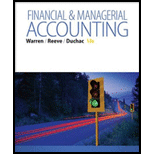
a)
Product pricing: Product pricing is the method used for fixing the price for the products sold or the services offered to the consumers.
Product cost pricing: Product cost pricing is a pricing technique which sums up the costs involved in the production of the product alone and the markup is added to the sum.
Total cost pricing: Total cost pricing is a pricing technique which sums up all the costs involved in the production of the product and the markup is added to the sum.
Total Variable Cost: Total variable cost refers to the costs involved in the production of the product.
Markup Percentage: The markup percentage is the percentage of additional costs added to the product cost to get the selling price of the product.
Selling Price: Selling price is calculated by summing up the product cost per unit and the per unit markup cost
To Determine: The desired profit of Company CD.
a)
Explanation of Solution
Desired Profit: Company CD aims at earning a profit of 15% of the total investment made of $1,500,000.
Calculate the desired profit of Company CD.
Hence, the desired profit of Company CD is $225,000
b)
On the basis of product cost concept, for Company CD
- i. Cost per unit
- ii. Markup percentage
- iii. Selling price of flat panel displays
b)
Explanation of Solution
Product cost pricing: Product cost pricing is a pricing technique which sums up the costs involved in the production of the product alone and the markup is added to the sum.
i)
Calculate the cost per unit of flat panel display.
| Variable Cost (1) | $1,000,000 |
| Fixed Cost | $250,000 |
| Total | $1,250,000 |
| Divide by: Number of units | 5,000 |
| Cost per unit | $250 |
Hence, the cost per unit of flat panel display is $250.
Working Note:
Calculate the variable cost.
c)
On the basis of total cost concept, for Company CD
- i. Cost per unit
- ii. Markup percentage
- iii. Selling price of flat panel displays
c)
Explanation of Solution
Total cost pricing: Total cost pricing is a pricing technique which sums up all the costs involved in the production of the product and the markup is added to the sum.
i)
Calculate the cost per unit of flat panel display.
| Variable Cost
|
$1,175,000 |
| Fixed Cost
|
$400,000 |
| Total | $1,575,000 |
| Divide by: Number of units | 5,000 |
| Cost per unit | $315 |
Hence, the cost per unit of flat panel display is $315.
d)
On the basis of variable cost concept, for Company CD
- i. Cost per unit
- ii. Markup percentage
- iii. Selling price of flat panel displays
d)
Explanation of Solution
Total Variable Cost: Total variable cost refers to the costs involved in the production of the product.
i)
Variable cost per unit of flat panel display is $235.
Total variable cost of flat panel display is $1,175,000
iii)
Calculate the selling price per unit of flat panel display
| Cost per unit | $235 |
| Markup per unit
|
$125 |
| Selling price per unit | $360 |
Hence, the selling price per unit of flat panel display is $360.
e)
To Comment: On any other considerations that would influence the price of flat panel display.
iii)
Calculate the selling price per unit of flat panel display
| Cost per unit | $235 |
| Markup per unit
|
$125 |
| Selling price per unit | $360 |
Hence, the selling price per unit of flat panel display is $360.
e)
Explanation of Solution
Calculate the selling price per unit of flat panel display
| Cost per unit | $235 |
| Markup per unit
|
$125 |
| Selling price per unit | $360 |
Hence, the selling price per unit of flat panel display is $360.
F (i)
To Prepare: The differential analysis of Company CD, for the proposed offer to either accept or reject it.
F (i)
Explanation of Solution
Prepare the differential analysis for Company CD for the given alternatives.
| Differential Analysis of Company CD | |||
| Reject Order (Alt 1) or Accept Order (Alt 2) | |||
| August 03 | |||
| Reject Order (Alternative 1) | Accept Order (Alternative 1) | Differential Effect on income | |
| Revenues | $0 | $180,000 | $180,000 |
| Costs | |||
| Variable |
$0 | (2) (-) $152,000 | (-) $152,000 |
| Income (loss), per unit | $0 | $28,000 | $28,000 |
Table (1)
The differential analysis of Company CD shows a profit of $28,000 on accepting the offer, hence the offer should be accepted.
Working Note:
Calculate the variable manufacturing cost.
Want to see more full solutions like this?
Chapter 24 Solutions
Financial & Managerial Accounting
- Answerarrow_forwardReliable Production company has a beginning finished goods inventory of $24,500, raw material purchases of $31,200, cost of goods manufactured of $42,800, and an ending finished goods inventory of $27,300. The cost of goods sold for this company is?arrow_forwardCan you help me solve this general accounting problem with the correct methodology?arrow_forward
- Please explain the correct approach for solving this general accounting question.arrow_forwardI need help with this financial accounting question using standard accounting techniques.arrow_forwardI need help finding the accurate solution to this general accounting problem with valid methods.arrow_forward
 Managerial Accounting: The Cornerstone of Busines...AccountingISBN:9781337115773Author:Maryanne M. Mowen, Don R. Hansen, Dan L. HeitgerPublisher:Cengage Learning
Managerial Accounting: The Cornerstone of Busines...AccountingISBN:9781337115773Author:Maryanne M. Mowen, Don R. Hansen, Dan L. HeitgerPublisher:Cengage Learning Managerial AccountingAccountingISBN:9781337912020Author:Carl Warren, Ph.d. Cma William B. TaylerPublisher:South-Western College Pub
Managerial AccountingAccountingISBN:9781337912020Author:Carl Warren, Ph.d. Cma William B. TaylerPublisher:South-Western College Pub Principles of Cost AccountingAccountingISBN:9781305087408Author:Edward J. Vanderbeck, Maria R. MitchellPublisher:Cengage Learning
Principles of Cost AccountingAccountingISBN:9781305087408Author:Edward J. Vanderbeck, Maria R. MitchellPublisher:Cengage Learning Survey of Accounting (Accounting I)AccountingISBN:9781305961883Author:Carl WarrenPublisher:Cengage Learning
Survey of Accounting (Accounting I)AccountingISBN:9781305961883Author:Carl WarrenPublisher:Cengage Learning



